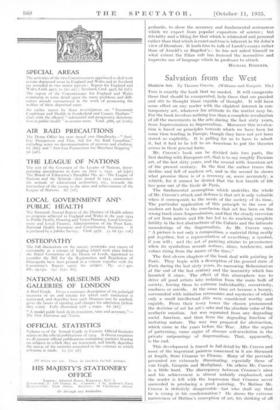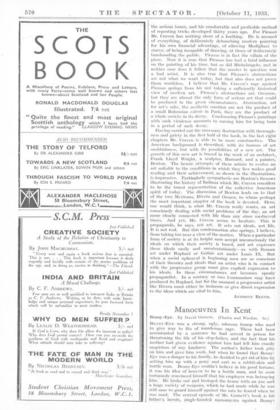Salvation from the West
Tins is exactly the book that we needed. It will exasperate those that should be exasperated, help those that are puzzled and stir to thought those capable of thought. It will have some effect on any reader with the slightest interest in con- temporary art, whatever his attitude to the matter may be. For the book involves nothing less than a complete revaluation of all the movements in the arts during the last sixty years, from Impressionism to Superrealism. Moreover this revalua- tion is based on principles towards which we have been for some time tending in Europe, though they have not yet been stated so explicitly. It is galling for us to have to admit it, but it had to be left to an American to put the theories across in their general form.
Mr. Craven's book can be divided into two parts, the first dealing with European art, that is to say roughly Parisian art, of the last sixty years, and the second with American art of the present century. In the first the author traces the decline and fall of modern art, and in the second he shows what promise there is of a recovery or, more accurately, a rebirth, for it cannot be denied that the last breath of life has gone out of the Ecole de Paris.
The fundamental assumption which underlies the whole of Mr. Craven's attack and defence is that art is only valuable when it corresponds to the needs of the society of its time. The particular application of this principle to the case of modern art leads to the conclusion that art has been on the wrong track since Impressionism, and that the steady recession of art from nature and life has led to its reaching complete futility in the last abstractions of the Cubists and the intimate meanderings of the Superrealists. As Mr. Craven says,
4 picture is not only a composition, a material thing neatly put together, but a representation of something, a symbol, if you will ; and the art of painting attains to prominence when its symbolism reveals notion's, ideas, tendencies, and values rising from the mores of the time."
The first eleven chapters of the book deal with painting in Paris. They begin with a description of the general state if Paris during the last sixty years, its narrowing Bohemianism at the end of the last century and the insecurity which has haunted it since. The effect of this atmosphere was to drive all good artists into isolation from the main bulk of society, forcing them to extreme individuality, eccentricity, madness or suicide. At the same time art became a luxury, surrounded with initiation ceremonies and mysteries of which only a small intellectual Me were considered worthy and capable. From their ivory tower the chosen pronounced the doctrine of art for art's sake and the absolute value of the aesthetic emotion. Art was separated from any degrading social function, and then from the degrading function of imitating nature. The way was prepared for abstraction, which came in the years before the War, After the orgies of patterning, came orgies of obscure self-revelation in the private outpourings of Superrealistn. That, apparently, is the end.
This development is traced in full detail by Mr. Craven and most of the important painters concerned in it are discuSsed at length, from Cezanne to Picasso. Many of the portraits presented are extremely illuminating, especially those of van Gogh, Gauguin and Modigliani. On others Mr. Craven ' is a little hard. The discrepancy between '• Cezanne's aims and his achievement is almost unfairly emphasised, and the reader is left with the impression that Cezanne never succeeded in producing a good painting, To Matisse Mr. Craven is definitely disagreeable—but who shall say that he is wrong in his condemnation ? He shows the extreme narrowness of Matisse's conception of art, his shirking of all the serious issues, and his comfortable and Profitable method of repeating tricks developed thirty years ago. For Picasso Mr. Craven has nothing short of a loathing. He is accused of everything, of deliberately debauching modern painting for his own financial advantage, of allowing Modigliani to starve, of being incapable of drawing, at times of deliberately bamboozling the public. Picasso is in fact the villain of the 'piece. Now it is true that Picasso has had a fatal influence on the painting of his time, but so did Michelangelo, and in neither case does it follow that the master in question was. a bad artist. It is also true that Picasso's abstractions are not what we want today, but that also does not prove. them worthless. I believe that Mr. Craven's rage against • Picasso springs from his not taking a sufficiently historical view of modern art. Picasso's abstractions are tiresome,, but they are almost the only form of serious art that could. be produced in the given circumstances. Abstraction, art for art's sake, the aesthetic emotion are not the product of a small Bohemian coterie in Paris, they are the product of a whole society in its decay. Condemning Picasso's paintings with'subh virulence amounts to cursing him for being born in a period of such decay.
Having carried out the necessary destruction with thorough-. ness and gaiety in the first half of the book, in the last eight chapters Mr. Craven is able to be more constructive. The American background is 'described, with its horrors of art snobbishness, but with its possibilities of a new art. The growth of this new art is traced in the work of an architect,i, Frank Lloyd Wright, a sculptor, Barnard, and a painter,. Benton. The heroic attempts of these artists to evolve an art suitable to the conditions in which they live makes good reading and their achievement, as shown in the illustrations, is impressive. Fargspplarly sympathetic are Benton's frescoes illustrating the history of Indiana which Mr. Craven considers to be the truest representation of the collective American spirit of today. The discussion of Benton leads on to that of the two Mexicans, Rivera and Orozco, to whom perhapi the most important chapter of the book is devoted. Here; one would think, is what Mr. Craven really wants, an art consciously dealing with social problems of the day, an art more closely connected with life than any since mediaeval times. And yet, Mr. Craven seems to hesitate. This is propaganda, he says, not art. It sets out ideals, not life. It is not real. But this condemnation also springs, I believe, from taking too near a view of the matter. When a particular form of society is at its height men accept unconsciously the ideals on which their society is based, and art expresses these ideals easily and unostentatiously—as with Roman art under Raphael or Gothic art under Louis IX. But when a social upheaval is beginning men are so conscious of their theories and ideals that an artist who is in contact with the progressive group must give explicit expression to his ideals. In these circumstances art becomes openly propagandist. In a century or two Communism may have produced its Raphael, but for the moment a progressive artist like Rivera must either be insincere or give direct expression to the ideas which arc vital to him.
ANTIIONY BLUNT.































































 Previous page
Previous page